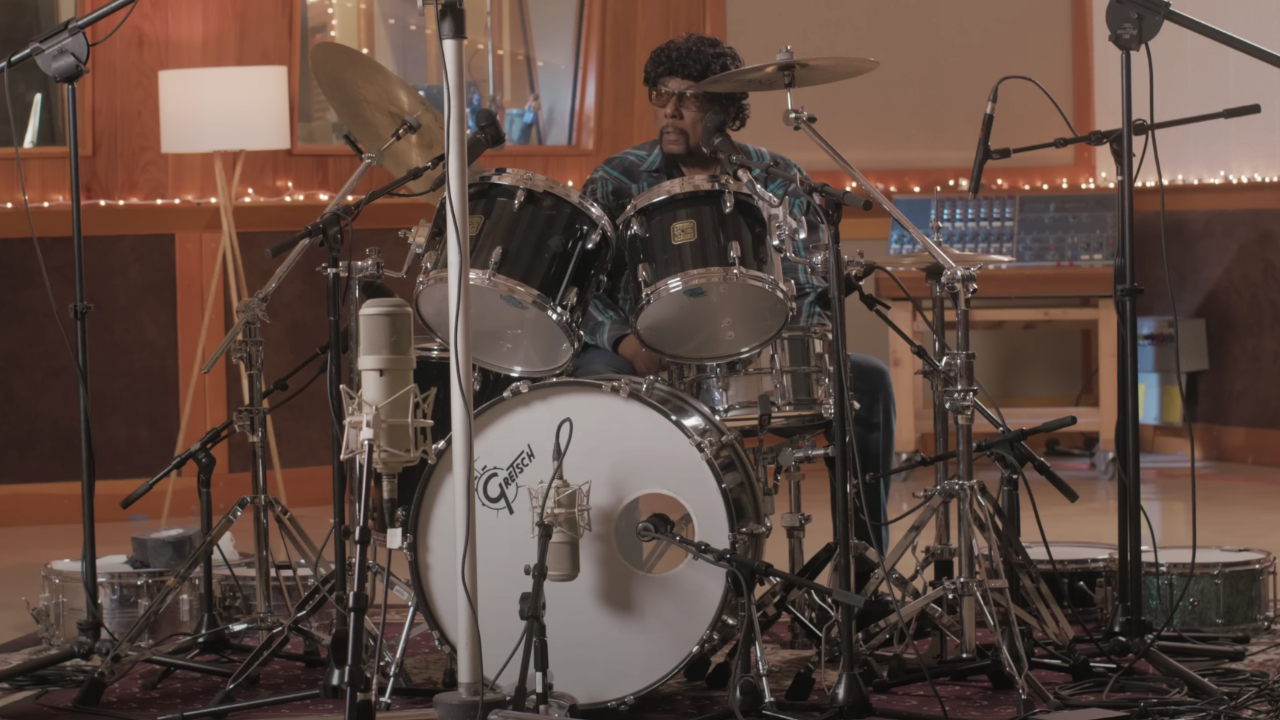
When it comes to impeccable groove and feel, few drummers come close to James Gadson. Throughout his career, Gadson’s beats created the bedrock for an incredible list of funk, soul and blues artists including Bill Withers, The Temptations, BB King, Marvin Gaye and many, many others.
As well as his relentless single-handed sixteenth notes, matched by a delicate touch that make his time-keeping glide and bounce, Gadson’s snare drum sounds enhanced the identity of hundreds of hits. But, they also went on to attract the attention of countless hip-hop producers, who sampled his infectious grooves.
In the latest episode of its SNARE series — produced by microphone company Lauten Audio at Foo Fighters’ Studio 606 to promote its new SNARE microphone — we get a glimpse into what goes into creating those vintage funk snare sounds.
But it’s not just about the snare tunings, as Gadson candidly plays his way through a cross-section of his career, demonstrating grooves he supplied to Charles Wright (Express Yourself), I Don’t Want You on My Mind (Bill Withers), I Will Survive (Gloria Gaynor) and Paper Tiger (Beck).
14"x5" Ludwig Acrolite
Gadson starts with a snare drum that many of us will be familiar with: a 14”x5” Ludwig Acrolite. This affordable aluminium-shelled snare was the ‘student’ version of Ludwig’s Supraphonic, featuring the same beaded, ‘Ludalloy’ shell but with fewer lugs (8 rather than 10), and forgoing the chromed finish in favour of a powder-coated exterior.
Ludwig Acrolites have seen a resurgence in recent years as a still-affordable vintage drum (although prices continue to rise), with a consistent, drier sound than say, brass.
He demonstrates his ‘by-ear’ approach to tuning his Acrolite, where he turns the snares off and ignores traditional advice on tightening lugs in diagonal pairs, instead tweaking each lug while listening for the ring of the batter head to develop.
Asked by Studio 606 engineer, Darrell Thorp on how he developed this approach, Gadson says, “It’s just something that I acquired, I guess from my ear. When I first started working at Motown, the engineers would have me come in at 07:30-08:00 o’clock in the morning and tune-up my drums.” says Gadson, “But it was a different way…I’d just tune it up to where I thought I could get that ‘pop’.”
He adds that tuning his snare drum to incorporate some overtones was also inspired by listening to James Brown records, “James Brown’s snares would ring, so you know, I thought that was what was happening. So that’s why I did it.”
14"x6.5" Ludwig Supraphonic LM402
Next up, Gadson switches to a Ludwig Supraphonic. His is the LM402 model, measuring 14”x6.5” vs the Supraphonic 400 and Acrolite’s 5-inch depth, the same drum favoured by John Bonham. However unlike Bonham, Gadson’s Supraphonic is tuned and taped for the quintessential fat, dead funk sound, however, Gadson notes that for disco beats, the snare would be tuned even lower.
“A lot of disco stuff, was tuned way down. I don’t want to mess [with the current tuning]…I mean, the tension rods would fall out. At that time, the kick and toms - the bottom heads were off so they had a certain way that they recorded. The disco thing, I think they wanted the snare to have that punch. It was about the depth, because they had those big speakers they used to use in New York. So this was down very low.”
14"x6.5" Pearl Jupiter
Finally, Gadson switches to a 14”x5” Pearl Jupiter. This sought-after (Stewart Copeland-approved) chrome-over-brass snare also features Pearl’s parallel action snare strainer, which not only tensions and releases the snares evenly, but also features extended snare wires covering the entire diameter of the snare head.
Gadson used a Jupiter model extensively for his work with Beck (Sea Change, The Information and Morning Phase), all three of which were engineered by Thorp.
“James would only bring…you had three Jupiters. Maybe two were 5” and one was a 6.5” then one of them had ‘Beck’ written on it so that he knew that was the drum. Because he never changed his heads! We did a session years post-[Sea Change], I think it might have been Morning Phase. I was like ‘Is that your normal Jupiter snare?’. He pulls it out and it says ‘Beck’!
“The thing about Beck” Gadson adds, “Is that he’s so adventurous. That’s what I really dug about him. You never knew what you were going to play, he would take you to the limits a lot of times. So I really enjoyed that, he brought in some great musicians, it was a great time.”
For more information on Snare Mic, check out Lauten Audio’s website.







